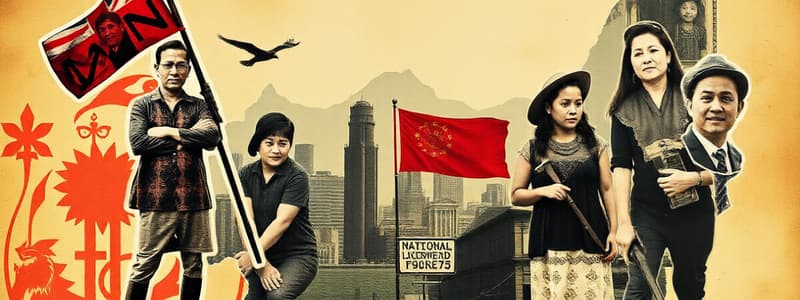Podcast
Questions and Answers
What was the primary reason for the formation of the Moro National Liberation Front (MNLF)?
What was the primary reason for the formation of the Moro National Liberation Front (MNLF)?
- To advocate for the creation of an independent Moro state due to perceived unfair treatment. (correct)
- To establish trade connections across Southeast Asia.
- To enforce the Indigenous Peoples' Rights Act (IPRA) in the Southern Philippines.
- To integrate Moro people into mainstream Philippine society.
Which of the following best describes the role of the National Commission on Indigenous Peoples (NCIP)?
Which of the following best describes the role of the National Commission on Indigenous Peoples (NCIP)?
- A political organization advocating for an independent Moro state.
- A legal entity responsible for enforcing trade agreements between the Philippines and Southeast Asian countries.
- An advocacy group supporting sustainable development projects in Muslim Mindanao.
- A government agency focused on protecting and promoting the rights and well-being of Indigenous Cultural Communities/Indigenous Peoples. (correct)
How does the NCIP protect the rights of Indigenous Peoples in the Philippines?
How does the NCIP protect the rights of Indigenous Peoples in the Philippines?
- By negotiating peace agreements with various Moro groups.
- By establishing autonomous regions with self-rule.
- By issuing Certificates of Ancestral Domain Titles (CADTs) and Certificates of Ancestral Land Titles (CALTs). (correct)
- By leading armed insurgencies against the Philippine government.
What does the term 'Bangsamoro' refer to in the context of the southern Philippines?
What does the term 'Bangsamoro' refer to in the context of the southern Philippines?
Which event directly led to the establishment of the Bangsamoro Autonomous Region in Muslim Mindanao (BARMM)?
Which event directly led to the establishment of the Bangsamoro Autonomous Region in Muslim Mindanao (BARMM)?
What was the significance of the 1996 Final Peace Agreement between the MNLF and the Philippine government?
What was the significance of the 1996 Final Peace Agreement between the MNLF and the Philippine government?
What factor contributed to the emergence of splinter groups from the Moro National Liberation Front (MNLF)?
What factor contributed to the emergence of splinter groups from the Moro National Liberation Front (MNLF)?
What role did the Sultanates of Sulu and Maguindanao play in the history of the Bangsamoro people?
What role did the Sultanates of Sulu and Maguindanao play in the history of the Bangsamoro people?
What impact did American colonization have on the Bangsamoro people?
What impact did American colonization have on the Bangsamoro people?
Which of the following is an example of legal protection provided by the NCIP?
Which of the following is an example of legal protection provided by the NCIP?
Flashcards
Moro National Liberation Front (MNLF)
Moro National Liberation Front (MNLF)
A political organization in the Philippines established in 1972, advocating for an independent Moro state.
National Commission on Indigenous Peoples (NCIP)
National Commission on Indigenous Peoples (NCIP)
A government agency in the Philippines that protects the rights and well-being of Indigenous Cultural Communities/Indigenous Peoples.
Bangsamoro
Bangsamoro
Collective identity of the Moro people, predominantly Muslim, living in the southern Philippines.
CADTs and CALTs
CADTs and CALTs
Signup and view all the flashcards
Indigenous Peoples' Rights Act (IPRA)
Indigenous Peoples' Rights Act (IPRA)
Signup and view all the flashcards
Moro Wars
Moro Wars
Signup and view all the flashcards
Bangsamoro Autonomous Region in Muslim Mindanao (BARMM)
Bangsamoro Autonomous Region in Muslim Mindanao (BARMM)
Signup and view all the flashcards
Study Notes
- IPRA stands for Ancestral Domains and Land
- Tausug is a term related to the topic
Moro National Liberation Front (MNLF)
- Arose in the Philippines in 1972 under Nur Misuari
- The MNLF initiated an armed insurgency aimed to create an independent Moro state
- The group transitioned to political means, leading to the 1996 Final Peace Agreement with the Philippine government
- The agreement established the Autonomous Region in Muslim Mindanao (ARMM), giving Moro people some self-rule
- Internal divisions resulted in groups like the Moro Islamic Liberation Front (MILF)
- The MNLF formed because Moro people in the southern Philippines felt unfairly treated
National Commission on Indigenous Peoples (NCIP)
- NCIP is a government agency in the Philippines
- The NCIP's role is to protect the rights and well-being of Indigenous Cultural Communities/Indigenous Peoples (ICCs/IPs)
- The NCIP issues Certificate of Ancestral Domain titles (CADTs) and Certificate of Ancestral land titles (CALTs)
- The NCIP supports Sustainable Development
- The NCIP provides Education and Advocacy
- The NCIP enforces the Indigenous Peoples' Rights Act (IPRA), which guarantees rights to self-governance, cultural integrity, and equal treatment under the law
- NCIP engages in Collaboration and Partnerships
Bangsamoro
- This term refers to the collective identity of the Moro people
- The Moro people are predominantly Muslim in the southern Philippines, specifically Mindanao, Sulu, and Palawan
- The Bangsamoro Autonomous Region in Muslim Mindanao was established in 2019 through the Bangsamoro Organic Law (BOL)
- The BOL followed peace negotiations between the Philippine government and Moro groups like the Moro Islamic Liberation Front (MILF)
- The Bangsamoro people had the Sultanate of Sulu and the Sultanate of Maguindanao
- Spanish colonizers in the 16th century marked the beginning of resistance
- The creation of the Bangsamoro Autonomous Region in Muslim Mindanao (BARMM) in 2019, granted the Bangsamoro people greater self-governance
Studying That Suits You
Use AI to generate personalized quizzes and flashcards to suit your learning preferences.




